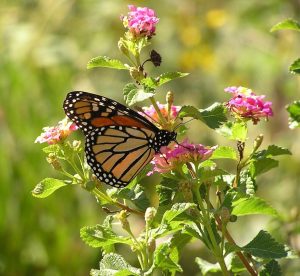By Emmy Ulmschneider
and Debbie Roland
Master Gardeners
It is Monarch migration time! The fifth generation is beginning their long trip to their Mexican overwintering grounds in the Monarch Butterfly Biosphere Reserve on the border of Michoacán and State of Mexico. To reach the winter preserve, the migrating Monarchs funnel through Texas. Texas is an important key to Monarch survival.
At the Federal level, in December 2020, it was determined that although the Monarch warranted listing under the Endangered Species Act, there were other species of higher priority. In July 2022, IUCN (International Union of Concerned Naturalists) listed migrating Monarchs on their red list which means they are two steps from extinction. Federally, the Monarch was given an “enhancement of survival.”
What this means is that permitted agencies can oversee and coordinate participation with partners who take voluntary conservation action. In this case the partners are the companies and agencies who oversee transportation and energy right of ways. The agreement encourages transportation and energy partners to participate in Monarch conservation by providing and maintaining habitat on potentially millions of acres of rights-of-way and associated lands. And this is already starting to happen here in Texas.

The numbers of migrating monarchs are measured by the area they occupy in Mexico. In 1976, Fred Urquhart “discovered” the overwintering site and estimated that the Monarchs he saw occupied over 20 hectares, a hectare being about the size of two football fields. Since the 1990’s, researchers have measured the winter roosting area which is an area of six hectares and is thought to be sustainable for the Monarch population. Last winter, 2022-2023, it was 2.21 hectares. The average area over the last 10 years is 2.72 hectares. There are many reasons for this including urban and agricultural development, use of herbicides and pesticides, loss of suitable habitat over the migrating area and light pollution. TLC for Monarchs must happen at the international, national, state, community and individual level.
One of the big debates over the last few years was the use of Tropical Milkweed Asclepias curassavica as a landscape plant in our yards. Tropical Milkweed is a popular, easily grown, non-native milkweed that is attractive to both humans and Monarchs and that is the problem. Native milkweeds die back after blooming and the protozoan parasite Ophryocystis elektroscirrha (OE) dies with them.
Tropical Milkweed grown in warmer areas, does not die back in the winter and OE remains alive and ready to infect any Monarch that uses that plant. Infected Monarchs can then spread this disease to other plants and other Monarchs. OE infections result in smaller, more fragile Monarchs, decreased health, and other deformities including crumpled wings or a less robust cuticle affecting the Monarch metabolism. Even mild infections of the parasite are harmful: decreasing health, shortening lifespans, and allowing the parasite to be passed to the next generation.
Bottom line, the rates of OE infection in Monarchs across the U.S. are on the rise in both the numbers of U.S. counties with infected Monarchs and the increase in the rate of heavily infected Monarchs. Texas is no exception and in the southern warmer regions of Texas as well as the southeast United States, 2020 results showed that 47.9% of the Monarchs were infected with OE. Infection rates are highest in areas that are warm enough to have overwintering Monarch populations and year-round milkweed. And possible causes of this rise seem to correlate with human behaviors such as captive rearing of Monarchs and the planting of Tropical Milkweed especially in areas without hard freezes.
If you have questions call the AgriLife office in Odessa at 498-4071 or in Midland at 686-4700. Additional information, and our blog for access to past articles, is available at westtexasgardening.org. Click on “Resources.”




